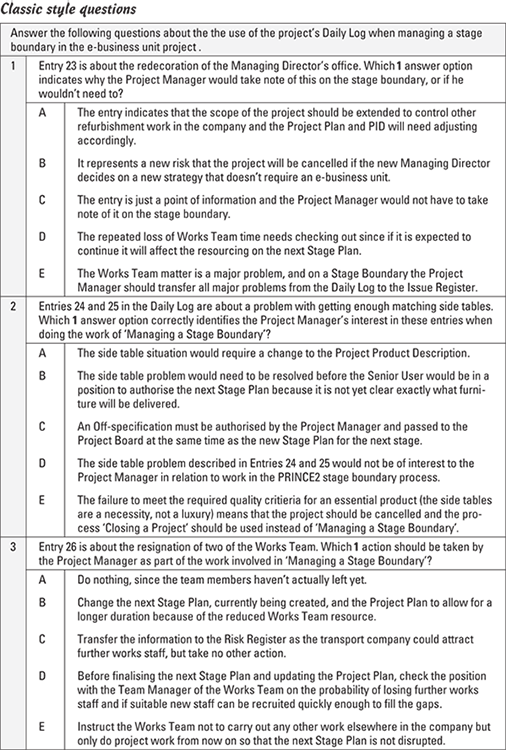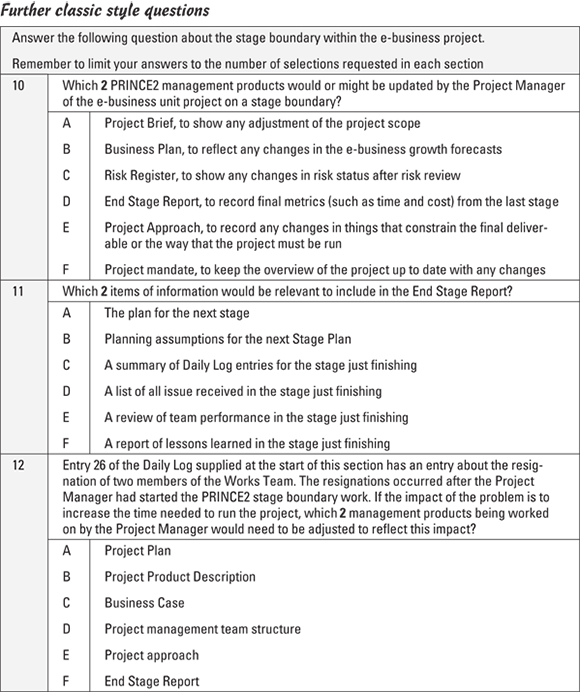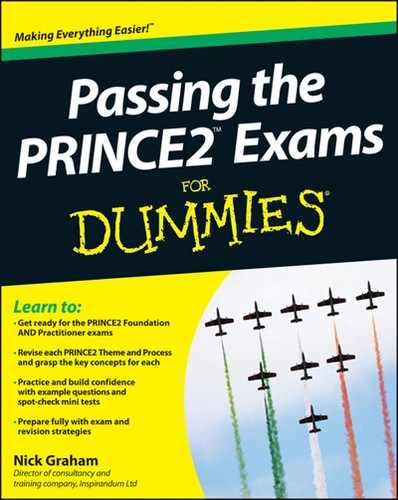Practising With Some Questions
This next section gives some questions to practise with. All the questions are based on the stage boundary process, so you can have a go with them as you progress with your learning of PRINCE2 or revise this area after you’ve learned the whole method.
If you’re studying for just the Practitioner exam having already passed Foundation, you may still like to have a quick go with the Foundation questions – which, of course, you should now get completely right, and very rapidly too. However, in the extremely unlikely and almost unimaginable event of you getting a Foundation question wrong, it can warn you of a gap in your knowledge which it’s best to find now, before the Practitioner exam, while there’s still time to do something about it.
Foundation-level questions
Test your knowledge of Managing a Stage Boundary with these Foundation-level questions. Set your timer for eight minutes. You can find answers and explanations at the end of the chapter.
1. Which of the following is an activity in the process Managing a Stage Boundary?
![]() a) Reporting stage end
a) Reporting stage end
![]() b) Updating the Project Initiation Documentation (PID)
b) Updating the Project Initiation Documentation (PID)
![]() c) Updating the Stage Plan
c) Updating the Stage Plan
![]() d) Reporting exception options
d) Reporting exception options
2. When should the process Managing a Stage Boundary be performed?
![]() a) During Initiation to produce a Stage Plan for each stage in the project
a) During Initiation to produce a Stage Plan for each stage in the project
![]() b) Only if a stage goes into exception and requires an Exception Plan
b) Only if a stage goes into exception and requires an Exception Plan
![]() c) Only when instructed by the Project Executive, based on exact control needs
c) Only when instructed by the Project Executive, based on exact control needs
![]() d) At, or close to the end of, each management stage except the last stage
d) At, or close to the end of, each management stage except the last stage
3. PRINCE2 expects the Business Case to be updated as part of the work of Managing a Stage Boundary. Which PRINCE2 principle does this primarily support?
![]() a) Focus on benefits
a) Focus on benefits
![]() b) Tailor to suit the project environment
b) Tailor to suit the project environment
![]() c) Continued business justification
c) Continued business justification
![]() d) Learn from experience
d) Learn from experience
4. Which role is responsible for updating the Benefits Review Plan, if required, at the end of a stage?
![]() a) Executive
a) Executive
![]() b) Business Assurance
b) Business Assurance
![]() c) Project Manager
c) Project Manager
![]() d) Project Support
d) Project Support
5. Why is the Quality Register updated in the process Managing a Stage Boundary?
![]() a) To enter the results of all the tests performed in the stage just finishing
a) To enter the results of all the tests performed in the stage just finishing
![]() b) To record any changes in the responsibilities for achieving the required quality levels in the project
b) To record any changes in the responsibilities for achieving the required quality levels in the project
![]() c) To enter details of quality management activities required in the following stage
c) To enter details of quality management activities required in the following stage
![]() d) To enter the total cost of quality activity in the stage just finishing
d) To enter the total cost of quality activity in the stage just finishing
6. In the process Managing a Stage Boundary, which of the following is NOT part of the stated purpose of providing the Project Board with information?
![]() a) So the board can review the success of the current stage
a) So the board can review the success of the current stage
![]() b) So the board can confirm continued business justification
b) So the board can confirm continued business justification
![]() c) So the board can review Team Plans to ensure that they’re achievable
c) So the board can review Team Plans to ensure that they’re achievable
![]() d) So the board can confirm that the risks remain acceptable
d) So the board can confirm that the risks remain acceptable
7. Within the PRINCE2 process Managing a Stage Boundary, which of the following activities should be done immediately after the activity ‘Update the Project Plan’?
![]() a) Report end stage
a) Report end stage
![]() b) Plan the next stage
b) Plan the next stage
![]() c) Review product status
c) Review product status
![]() d) Update the Business Case
d) Update the Business Case
8. Which other PRINCE2 process is triggered by the process Managing a Stage Boundary?
![]() a) Directing a Project
a) Directing a Project
![]() b) Closing a Project
b) Closing a Project
![]() c) Controlling a Stage
c) Controlling a Stage
![]() d) Managing Product Delivery
d) Managing Product Delivery
9. Which of the following events can trigger the process Managing a Stage Boundary?
A. Nearing the end of a delivery stage, except the last stage in the project
B. Ad hoc direction from the Project Board
C. Nearing the end of the Initiation Stage
D. Nearing the end of work in the process Starting Up a Project
![]() a) A, B and C
a) A, B and C
![]() b) A, B and D
b) A, B and D
![]() c) A, C and D
c) A, C and D
![]() d) B, C and D
d) B, C and D
10. Which of the following plans is created in the process Managing a Stage Boundary?
![]() a) Project Plan
a) Project Plan
![]() b) Team Plan
b) Team Plan
![]() c) Benefits Review Plan
c) Benefits Review Plan
![]() d) Exception Plan
d) Exception Plan
Practitioner-level questions
Read through the additional scenario and then try to answer the 12 questions in 18 minutes or less. In the exam itself, you won’t get a whole section on just one process, and a section involving Managing a Stage Boundary will also include questions on Closing a Project and Directing a Project. Also in the exam, you’ll have 10 questions and about 15 minutes to deal with them. Because there are 12 questions to practice with here, allow yourself slightly longer – 18 minutes – for answering. The 18 minutes includes any re-reading of the scenario information and looking anything up in the PRINCE2 manual.
Additional scenario
For the Practitioner questions in this chapter, please take into account the following additional project scenario information as well as the original information at the end of Chapter 2.
Extract from the Daily Log
Entry 23. 14 May. The Works Team has once again been called away from its project work to do maintenance work elsewhere – this time it’s for work in the new Managing Director’s office to replaster two walls and then redecorate. The new Managing Director has ordered that this be done as a top priority, so that he can settle in quickly after his appointment to the company. This is now the third time that works staff have been called away to do other things.
Entry 24. 16 May. Called the furniture supplier at 3 p.m. this afternoon to confirm everything is okay. Delivery of most new furniture will be on time, but there’s a problem in getting enough side tables of the same design as the desks in the time available before it’s necessary to furnish the office. The supplier can get enough side tables for three of the offices, but not for all four. A few other similar-looking side tables can be provided in time, but they aren’t exactly the same design as the desks.
Entry 25. 16 May. Checked with Kath Orford, the new manager of the e-business unit, about the side table supply matter (see log entry 24). She says that provided the tables look similar to the desks and are the right size, and the side tables within each of the four offices are the same design, she doesn’t have a problem if they don’t match the desks exactly. I’ve just emailed the Senior User as a heads up on this and am now recording an issue with a view to asking for a few side tables to be accepted off spec. See Issue Report 2/12.
Entry 26. 17 May. 11.15 am. Claire from the Works Office phoned to say that a few minutes ago two members of the Works Team handed in their resignations. These staff have been poached by a transport company which is moving into large office premises on the other side of town. The team members have given a month’s notice, but unfortunately each has two weeks’ annual leave owing, which means they’ll actually leave in two weeks. That will be before the end of the project and leave the Works Team short-staffed for the painting and wallpapering work, unless replacement staff can be recruited very rapidly. The impact of these resignations needs to be determined quickly, because we’re near stage end. I’m more than half way through preparing the next Stage Plan, and that will be affected.



Answers to the Foundation-level questions
1. a. This is the last activity in the process, as a look at the process model reveals.
2. d. At the end of a stage, just before the next one begins. The exception is the last stage where the Closing a Project process is used instead. The exclusion of the last stage in a project is a significant point but one the manual forgets to mention, thereby making that part of the purpose statement very misleading; so be careful you don’t get misled! [Manual 17.1]
3. c. The Business Case must be reviewed at least at the end of every stage. Be careful with ‘Focus on benefits’. It sounds rather good, but it isn’t one of the seven PRINCE2 principles.
4. c. The Project Manager is responsible for most of the updates of products on a stage boundary; this information provides good grounds for guessing if you weren’t absolutely sure.
5. c. The Quality Register lists all the quality activities in a stage so that each can be signed off when it’s done – it acts as a sort of checklist. The stage boundary is where that list gets put into the register for the following stage.
6. c. You can get to the right answer in one of two ways. The first is by being familiar with the elements of the purpose statement, and the second is by remembering that the Project Board members don’t see Team Plans; the team plans are too low a level of detail for the board to be concerned with.
7. d. Again, the process model reveals the answer. For the exam, it helps if you have a photographic memory – but, if not, the logic of the process should help. After the plans have been updated, there may be new forecasts of time and cost, and both of these are included in the Business Case.
8. a. This is for the Project Board activity ‘Authorize a Stage or Exception Plan’ in the process Directing a Project.
9. a. Remember that Start Up isn’t a stage. Instead, the work of stage planning (for the Initiation Stage) is covered by one of the activities of Starting Up a Project, not by calling the stage boundary process to do it.
10. d. The key word here is ‘created’. The Project Plan and Benefits Review Plan are updated, not created. Team Plans are created in the first activity in the process Managing Product Delivery.
Answers to the Practitioner-level questions
Classic-style questions
1. D. Project resource is getting depleted. This needs checking out with the Senior Supplier, because the promised resource is not forthcoming. If resource levels can’t be met – and it’s quite hard to argue with a Managing Director – then the plans must be rebalanced to take account of the lower level of resource. That might be by extending the time needed to complete the project or by spending money to buy in additional help from a decorating company. It looks serious enough to justify handling as a formal issue.
2. D. The matter will need to be resolved, and as an issue which is probably going to be an Off-specification. However, it’s not a huge problem and won’t have an impact on the stage planning for the next stage or the End Stage Report. If a concession is made to accept a few side tables off specification, then remember that according to the manual, a concession can only be authorised by the Project Board and not by the Project Manager, as suggested in answer C.
3. D. This question is slightly messy and is to stretch you a bit in your understanding of PRINCE2. The process Controlling a Stage doesn’t stop while the stage boundary work is being done; and that’s the subject of a later question. Inevitably, then, there’s going to be some crossover between the two. The issue will be dealt with as part of the stage control, but it does have an impact on the preparations for the next stage. In projects, of course, you don’t think to yourself, ‘Ah, I’m now going back to the process Controlling a Stage before I return to continue my work in Managing a Stage Boundary’! Instead, you just get on with it. But if you analyse what you’re doing, then in PRINCE2 terms you’re actually dealing with the two processes in parallel, using appropriate activities from each.
Assertion–reason style questions
4. E. The Project Manager updates the Business Case on a stage boundary, although he or she should consult the Executive. [Manual Table 17-3]
5. D. The baselined version is kept for later comparison, but it doesn’t mean that the documentation is frozen. A lot of the updating in the process is to do with the Project Initiation Documentation (PID).
6. E. A nice thought, but sadly multi-tasking goes with the territory in project management. Make sure that you understand how some processes run in parallel; for more on this, have a look at Chapter 19.
7. D. Configuration Item Records must be created for newly identified products, but in any case some management products are being configuration managed, not just the specialist products that the teams are involved with.
8. D. Where an Exception Plan is being produced at a point part way through a stage, there’s no point in re-planning work that’s already done. That part of the work is shut down as an end stage and has an End Stage Report.
9. A. Really the team structure should be kept up to date all the time, but the manual does show it being checked and updated in the stage boundary process.
Further classic-style questions
10. C and E. Again take note of the word ‘updated’. There’s no Business Plan in PRINCE2, and the mandate and brief are long gone by the time of the delivery stages.
11. E and F. Check out the report in Appendix A of the manual. [Manual A.9.2]
12. A and C. Both the Project Plan and Business Case include project duration information, and the Project Plan also contains resource plans. Team members aren’t be in the project management team structure, because they’re not in the project management team.
